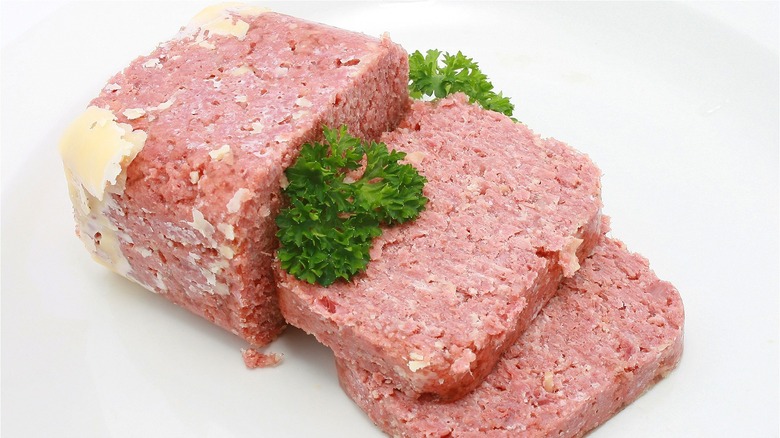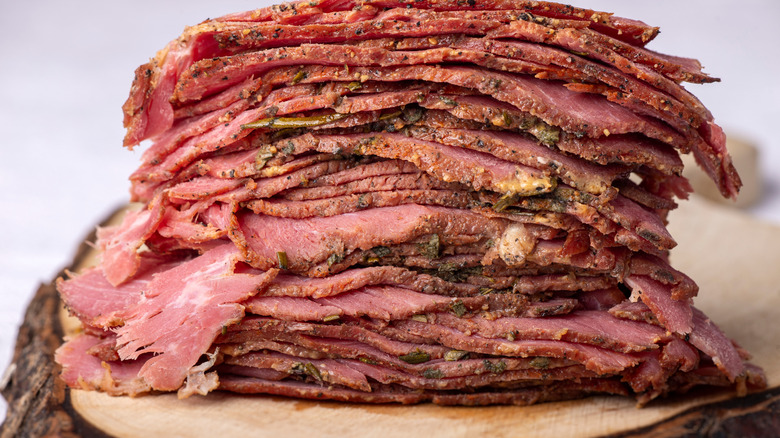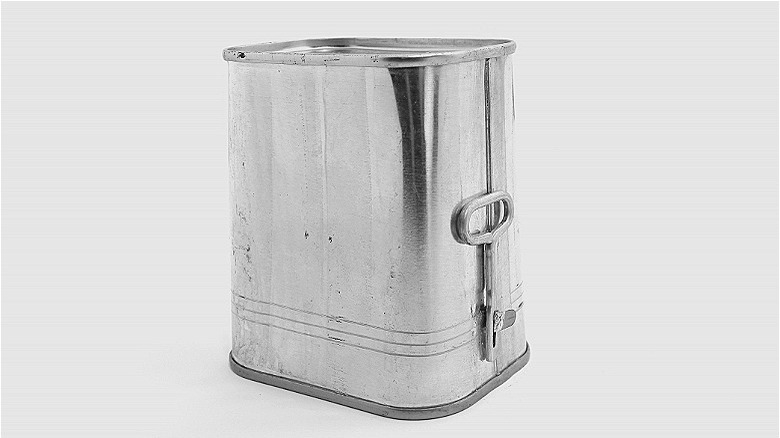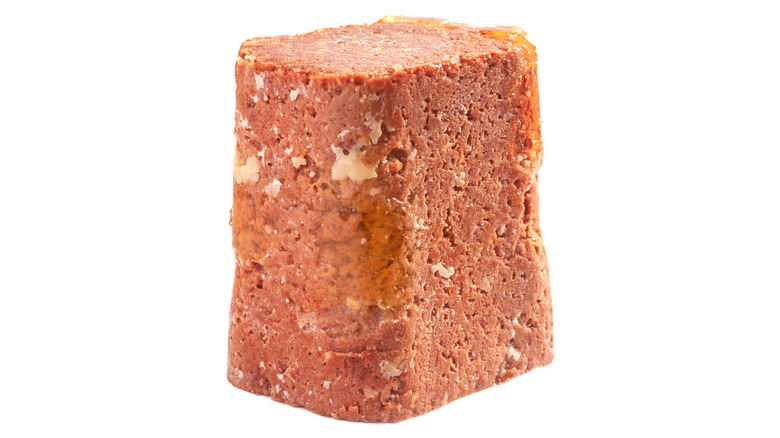We Finally Know What The White Stuff In Canned Corned Beef Really Is
Canned corned beef, the tender meat with a white gelatinous substance around its edges, may not be as illustrious as burger patties and bacon, but it has its place in history, according to Smithsonian Magazine.
Corned beef, or "salted beef" as it was known in the era of its conception, has traveled numerous circuits of human endeavor. European Cuisines writes that at first, it was considered a delicacy fit for the palates of royalty, as indicated by the 12th-century Irish poem "Vision of MacConglinne."
Ireland, in the 16th century, grew into a center of cattle husbandry thanks to the English appetite for beef. Unfortunately, due to an anti-Irish cattle lobby in Northern England (per Technological University Dublin), the Cattle Acts prohibiting the export of live cattle to England was imposed (per "A New History of Ireland: Volume III: Early Modern Ireland 1534-1691: Early" and Smithsonian Magazine). The latter threatened to create a glut in the Irish cattle market, so England's western neighbor found a loophole: They exported the four-legged commodities in inanimate form — most likely cured with brine in barrels, explains Washington Crossing Historic Park.
The corning of beef
As is now common knowledge, there is no corn in corned beef. So why is it called "corned beef"? When the British named the food in the 17th century, corn-sized granules of potassium nitrate or saltpeter (also used in gunpowder and matches) were used to salt the beef. This compound helped keep the meat from decaying while maintaining its appealing pinkish color, according to a 1921 book entitled "A Textbook of Inorganic Chemistry for Colleges" (via Web Archive).
Today the corning process remains mostly the same, says the United States Department of Agriculture: The meat is brined on low heat with spices and flavors at the discretion of its maker.
FoodHow notes that the uncanned or deli variations (often still referred to as "salt beef") have easily detectable differences. Firstly, they are available in two main brisket cuts: the point cut, which makes for fattier slices of meat as it comes from the part of the brisket that has more fat and marbling, and the flat cut, which is a leaner cut, according to Cleveland.com. Unlike store-bought canned corned beef, the fattier parts of deli variants are easily removed, per Masterclass, should one intend to minimize fat content.
The canning of beef
By 1668, but a year after the prohibitive 1667 Cattle Act, Cork, which had become one of the bastions of beef salting (among others in Waterloo, Belfast, and Dublin), was pushing out 16,960 barrels of corned beef every year. Also during this century, the first wave of Irish immigrants crossed the Atlantic for America with their knowledge of curing beef (per Technological University of Dublin); and, according to Smithsonian Magazine, it was during this period that the British named this dominant form of beef preservation "corning."
Favored for its longevity and ability to hold at sea, the now newly named corned beef gained traction during the wars of the 1800s. So prominent was its demand, that the French were permitted passage into Irish ports despite its war with England, according to the Technological University of Dublin.
Incidentally, canned corned beef was mass-produced for the first time in 1811, by British industrialist and paper maker Bryan Donkin (per Britannica). The packaging method allowed the bovine product to last longer and travel further. And it was barely 40 years later when Donkin's company started selling canned corned beef to the public, according to Canned Food UK.
The pink and white colors in canned corn beef
Another differentiating aspect among the variations of corned beef is color. Some batches have a dull grayish tone (especially in the deli variants), while others have delightful pink hues. The pinkish color, also prevalent in canned corned beef, is more appealing but may be less healthy than the gray variant as it contains sodium nitrite which contributes to its sodium content and may raise blood pressure (per Healthline). Also, a 2021 study published in the European Journal of Public Health reported a link between sodium nitrite and the risk for prostate cancer.
Modern-day canned corned beef comes from various unused cow parts that are not otherwise fit for sale. These cuts are slow-cooked in a saline solution (like their deli counterparts), ground, and mixed with nitrates, says Food How. Because the ground corned beef is canned while hot (a practice to prevent bacterial growth), any fat content becomes liquid, and as the meat cools, the fat solidifies, explains Food AQ.
According to a contributor on Stack Exchange's Seasoned Advice, a forum for chefs, the white substance is also a combination of water and collagen. The fact that beef brisket has a high percentage of collagen-rich tissue and fat, according to the Los Angeles Times, suggests that there is some weight to these claims.



